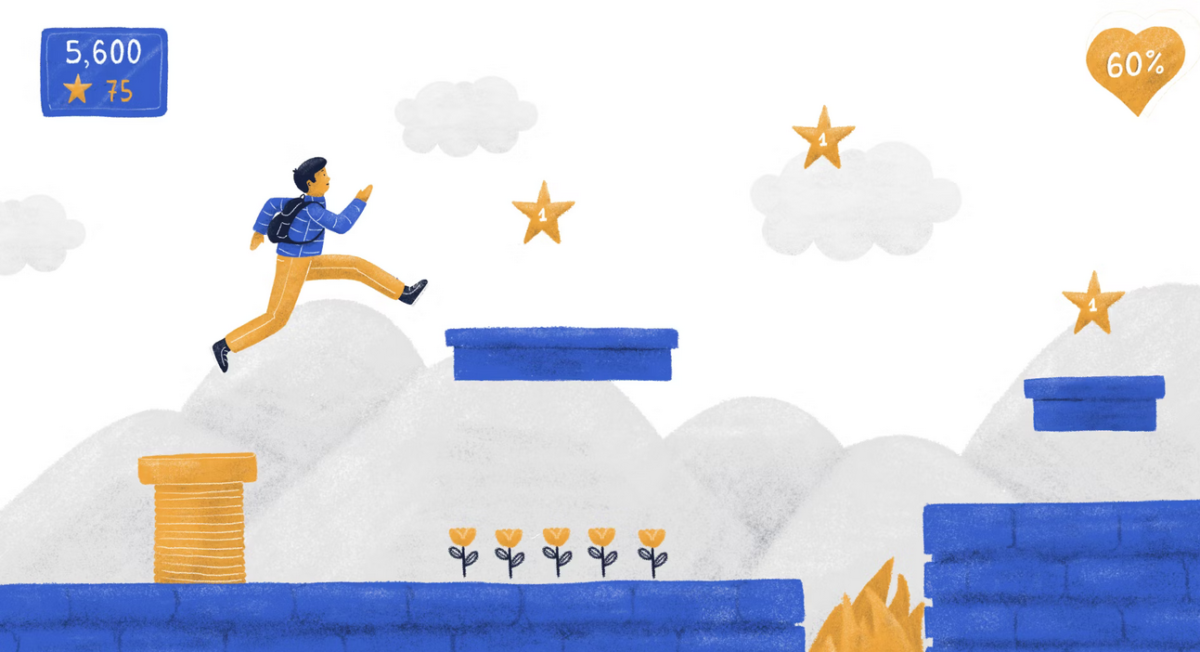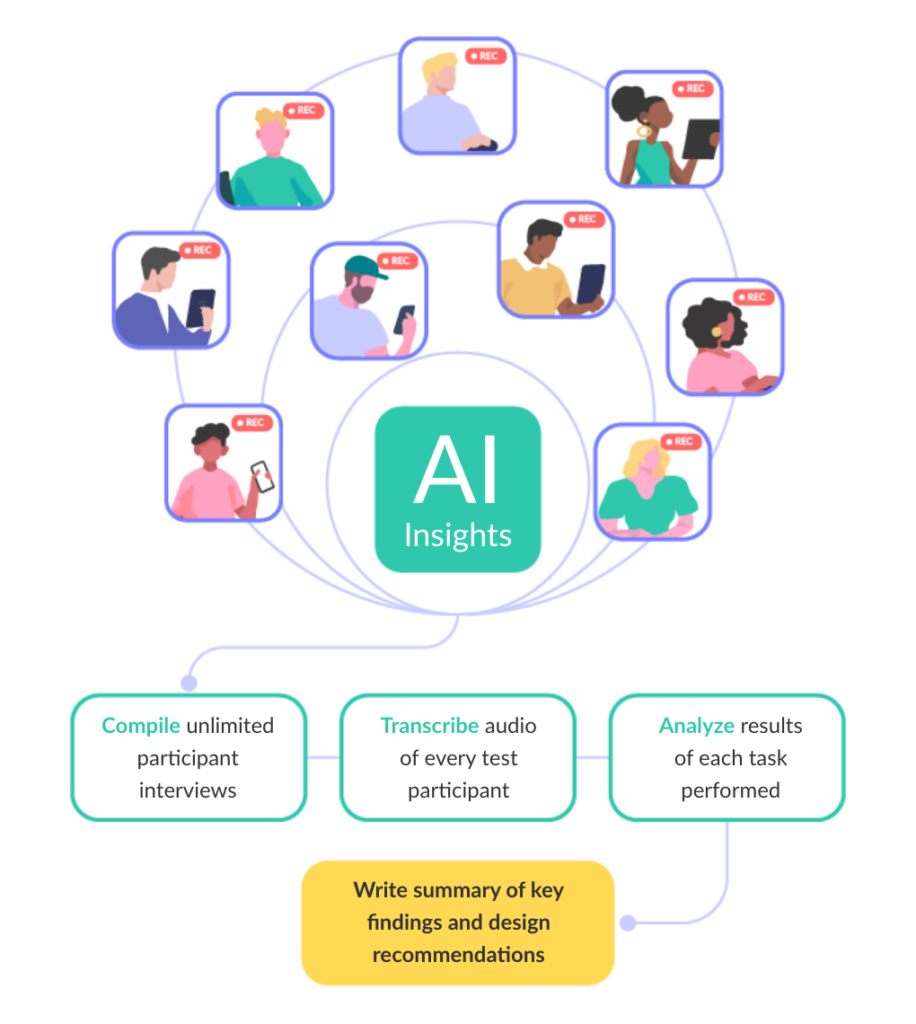Analyzing Your User Testing Data Just Got a Whole Lot More Easier
With AI Insights, you’ll be able to leverage the power of OpenAI’s and ChatGPT’s artificial intelligence to gain insights from your user test data. The feature provides faster, more accurate results and enables informed decision-making about your product design. Here’s what AI Insights can do for you:

AI-Generated Summaries
AI Insights will write an AI-generated summary of audio transcriptions from every participant of your user tests, providing you with a quick and easy way to understand the results which includes recommendations for improvement.

Participant Summaries and Analytics
AI Insights will analyze the results of each task and provide participant summaries and analytics from your report. You’ll be able to see how each participant performed and how they compare to others.

Summary Reports
AI Insights will write a summary report of your project, including key findings and design recommendations. You’ll be able to see the big picture and make informed decisions about how to improve your product…instantly!

Experience the Power of Artificial Intelligence in User Testing!
AI Insights is the perfect solution for organizations of all sizes. Whether you’re a small startup or a large enterprise, AI Insights will help you get the most out of your user testing efforts with Loop11.
AI Insights Benefits You Will Love
AI Insights offers several benefits that make it an ideal tool for any organization. With AI Insights, you’ll be able to:

Get Faster Results
AI can analyze a lot of user data quickly, providing results faster than if you did it manually.

Achieve Better Accuracy
AI can identify patterns in user data that might be missed by humans, resulting in more accurate results.

Save Money
AI can automate parts of the testing process, reducing the need for manual work and making user testing much more cost-effective.

Scale Your User Testing Efforts
AI Insights enables scalable user testing with larger groups of people, providing more comprehensive and representative data in a fraction of the time, leading to informed design decisions based on data from a diverse user base.

Efficiently Analyze User Data
AI can analyze a large amount of user data and identify trends, patterns, and information that can help improve the user experience.

AI Prompt Editing
AI Insights allows for personalization of AI prompts to focus on the specific UX issues of your project.

Our Clients Say It Best

“Loop11 saves us lot of time because we can reach more people than we could if we were doing in-person interviews.”


“Loop11 has been easy for us on the back end to capture, download the video and manipulate what we need using the admin software that Loop11 provides to us.”


“This remote usability testing tool gives you loads of excellent reporting features!”
Discover More Features of Our Online User Testing Platform
Explore our features that allow you to easily manage your testing projects and obtain valuable feedback from your users.
Online Usability Testing
Unmoderated Usability Testing
Prototype Testing
Moderated Usability Testing
Information Architecture (IA) Testing
UX Benchmarking
A/B Testing
True Intent Studies
Mobile & Tablet UX Testing
User Session Recording & Replay
Search Engine Findability
Clickstream Analytics
Heatmap Analysis
AI Browser Agents
The Role of Artificial Intelligence in UX Design
Technology is advancing at an incredible pace, bringing us an explosion of amazing apps! Thanks to Artificial Intelligence (AI) and Machine learning (ML), the way apps interact with users is now more intuitive and personalised. As these new technologies continue to evolve, it’s getting even more exciting in the field of UX. The future’s looking brighter and smoother as we work to create interfaces that are super easy for everyone to use, no matter their level of tech-savvy.
Does this sound like you:
- Spending countless hours on tedious data analysis tasks
- Finding it hard to keep up with the fast pace of business growth while gaining real-time insights
- Frustrated with the limitations of your current analytics tool that makes it tough to collect, correlate, and visualise the data you need
With big data and AI in the limelight and consumers embracing an “always-on” sharing lifestyle, thanks to widespread internet access, NOW is a great opportunity for brands to offer exceptional experiences that will help them get more sales. However, are they doing enough to learn why customers buy or abandon their shopping carts before making that purchase?
Those who understand the importance of investing in smart tools know that this will help them make quicker, more informed decisions and boost conversion. Online user experience (UX) plays a crucial role in this process; it’s the difference between a sale and no sale, between gaining a loyal customer or losing them.
Just look at game-changers like Uber, Apple, and Amazon to see the magic of amazing user experience. These disruptors make friction disappear, both online and in real-time, with their seamless and user-friendly design. At the end of the day, your customers don’t want to know the nitty-gritty of things; they want to know it works for them!
AI-powered UX is all about using artificial intelligence to enhance user experience and make better digital products. Think about websites, apps, and other interactive interfaces that you use. AI can help make these things more personalised, efficient, and easy to use. For example, a chatbot that mimics an interaction with a live agent is a classic example of AI-powered UX in action. The idea is to use data and machine learning to understand what your users like, how they interact with your product, and how you can make their experience more enjoyable.
Have you ever thought about how cool it would be if machines could do things just like us humans? Artificial intelligence is when machines can do things that generally only humans can do, like think, reason, and make decisions. AI is more than just machine learning; it’s a computer’s way of replicating human cognition.
AI has many practical uses: voice and speech recognition, computer vision, decision-making, natural language processing (NLP), machine learning, and robotics. AI can transform our daily lives, revolutionising industries like design, marketing, and customer service. Can you imagine having a more personalised and efficient experience with the things you use every day?
Let’s dive into the world of UX. Have you noticed how AI and User Experience (UX) go hand in hand? AI can enhance the user experience, and a well-designed UX can make AI more accessible and user-friendly. Here’s the thing: for AI to really shine and reach its full potential, good UX design is a must. It’s all about finding balance in automation and human-centred design.
Here are some ways AI can help with better UX:
- Automate customer service processes, resulting in cost savings and improved efficiency
- Gain insights into customer preferences and needs, enabling them to offer personalised experiences that will keep customer retention high
- Enhances user experience through intuitive and customised interactions and supports product improvement by analyzing user behavior and providing data-driven insights
- Assists UX designers in creating user-centric products, leading to increased user engagement and loyalty
- Research and Audit: The team will do user research, review the data gathered, and develop product specifications.
- Ideation: The team then sketches ideas and sits down in a brainstorming session with stakeholders. Usually, these ideas are translated into low-fidelity wireframes.
- Mockup Creation: This can be hours or days of polishing low-fidelity designs and turning them into digital (and sometimes interactive) mocks.
- Prototyping: Mocks are then created into product prototypes to help envision the design more accurately.
- Validation: This is when the user tests the design to check for any usability issues, and designers consider the feedback in proposing changes.
- Coding: Here’s where the developers step in and turn the prototype into a product.
- AI-based User Testing Services: Many AI tools can be used to power user testing. It’s all about automating specific tasks so you can focus on what matters most for your business. Our AI-powered user testing platform can help you to analyse data and identify pain points and areas for improvement – faster.
- AI-based User Testing Data Analysis: One of the most essential steps in using AI is to set up a data pipeline that allows you to collect, store, and analyse data from your tests. For example, you can have your tests automatically send screenshots and notes that can be analysed later. You can also have your tests automatically create a database.
- AI-driven User Research: One of the best ways to integrate AI into your user testing process is to power your user research. For example, you can use machine learning to identify the types of questions you should ask during your interviews. You can also use Natural Language Processing (NLP) to identify the key points from your interviews and then have the computer summarise the discussions.
- AI-based User Testing Insights: The most exciting aspect of AI is that it can help you make more accurate predictions. For example, AI can help you identify standard user states and recognize specific issues. It can also help you identify areas for improvement, such as problem areas.
- AI-based User Interface Design: A great way to integrate AI into your user testing process is to use it to power your design process. For example, you can use machine learning to identify common design elements and make design recommendations. You can also use NLP to make design recommendations, such as creating options for a specific style or colour.
- AI-powered User Testing Recommendations: Integrate AI into your user testing process to use it to power your testing process. This will help you spot common pain points and develop a UX strategy to improve specific design elements.
Real-time analysis of user data is one of AI technology’s most important testing uses. This makes testing more accurate and efficient while protecting user data from accidental or malicious violations.
AI technology can also be used to conduct surveys and analyse the data collected, creating models that can recognize user behaviour and generate insights about how customers interact with a product. This can help design surveys to capture the information needed for testing.
AI-based testing tools can generate insights faster and more accurately than ever before, making it easier for organisations to develop a better understanding of their users and uncover any potential problems.
While AI technology’s use for testing is experiencing rapid growth, it is still relatively new. As the technology matures and becomes more widely available, it will become more widely used, which can lead to even more profound impacts on the way user testing is conducted. In addition, as the technology continues to evolve, it will enable testing to be more accurate and efficient while generating more data in a shorter time.
- AI can help designers and developers to identify usability issues and pain points in the user interface. It can also provide valuable insights into user behaviour, helping to identify user preferences and spot conversion funnels.
- With its ability to rapidly identify and analyse user behaviour, AI can be used to predict user interaction and make recommendations for improvements.
- By leveraging AI, user testing can be done quickly, efficiently, and cost-effectively, with the potential to drive better user experience and higher conversions.
Latest UX resources
View all resources
Finding The Holes In Your Website’s UX
Fact #1: Many companies spend thousands of dollars on their website. Fact #2: Most of these companies have little idea whether their website is achieving its goals. UX testing is the mechanism that informs a company as to whether their website is working for them or against them. The following article provides a high-level report […]

10 Ways to Reduce Shopping Cart Abandonment
Every online store owner has encountered the problem of abandoned shopping carts. Shoppers will collect many things they are interested in buying from your business, but they will leave their coaches just before checking out. About 70% of all purchases are abandoned, according to research. If you are not taking this figure seriously, you may […]

Gamification in UX Design: Enhancing User Experience and Engagement
Gamification has become a crucial part of modern UX design. Let’s explore the gamification tools you should use in your UX strategy.
Unlock the Power of AI for Your UX Design Projects
Loop11 makes data analysis and reporting a breeze by combining the best of both worlds – human creativity and artificial intelligence technology. With this dynamic duo, you’ll get insights that are accurate and easy to understand.














